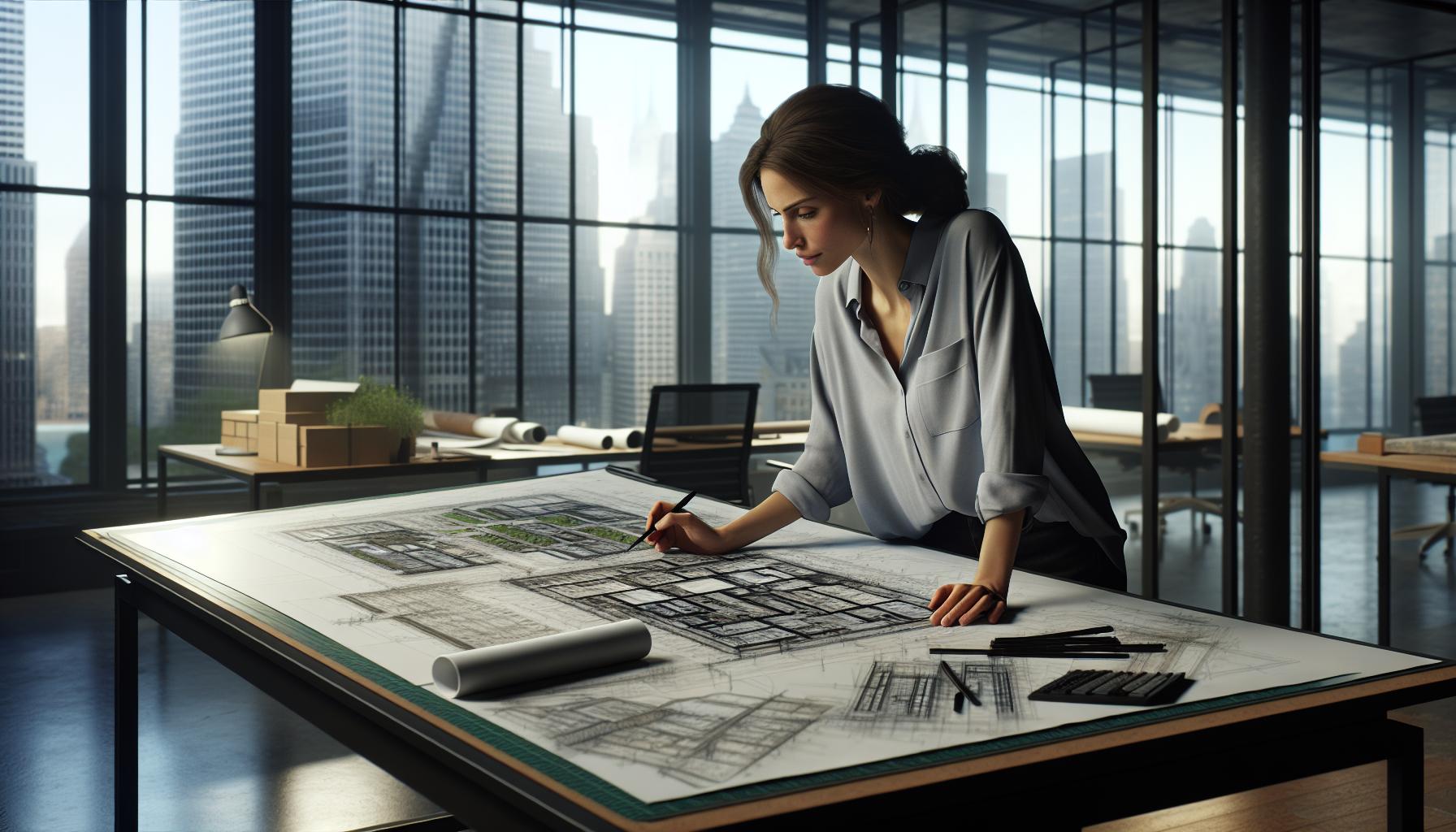Architectural design isn’t just about making buildings look pretty; it’s a thrilling journey from concept to completion. Picture this: an empty lot transforms into a stunning structure, all thanks to a well-planned design process. But wait, there’s more! Each phase of architectural design is like a carefully crafted recipe—mixing creativity, technical know-how, and a sprinkle of patience to whip up something extraordinary.
Architectural Design Phases
Architectural design phases consist of several stages, each critical to the overall success of a project. During the initial phase, known as programming, architects gather essential information such as client needs, budget parameters, and site restrictions. Thorough discussions lead to a clear understanding of project goals.
Schematic design follows, focusing on conceptualizing the project’s layout. Architects create preliminary drawings and explore various design options. Collaboration with clients happens frequently to ensure alignment with their vision.
The design development phase bridges the gap between concepts and detailed execution. Detailed drawings emerge, showcasing dimensions, materials, and systems. Architects finalize plans and specifications, preparing for the next step.
Construction documents constitute a crucial phase, where all the details become formalized in comprehensive documentation. These documents, including drawings and specifications, guide construction teams during the building process. Accuracy is vital, as these plans are used for permits and contractor bids.
Finally, the construction administration phase involves monitoring the building process. Architects maintain communication with contractors, ensuring compliance with the design intent and objectives. Regular site visits help address any issues that arise, ensuring successful project completion.
Each architectural design phases plays a unique role, contributing to the transformation of an empty lot into a remarkable structure. Attention to detail during each stage enhances design quality and overall project success.
Pre-Design Phase

The pre-design phase sets the foundation for architectural projects. It allows teams to clarify goals, gather vital information, and establish a strong direction.
Importance of Pre-Design
Pre-design plays a critical role in determining project success. Clarity gained during this phase helps architects align the design with client expectations. Stakeholders clarify their vision and requirements, ensuring a comprehensive understanding of needed functionality. Establishing a project budget early can prevent financial surprises later. Identifying site constraints further allows for informed design decisions that accommodate environmental factors. These elements together foster a collaborative environment that enhances communication throughout the design process.
Key Activities in Pre-Design
Key activities in the pre-design phase include research and information gathering. Architects conduct site analyses to identify zoning laws, building codes, and environmental considerations. Client meetings provide valuable insights into preferences, functionalities, and budget limits. Additionally, analyzing existing structures informs potential challenges and opportunities. Collaborating with engineers and consultants ensures a well-rounded perspective on project feasibility. Creating a project brief outlines all gathered information and serves as a reference throughout subsequent architectural design phases. These activities streamline the transition to later design stages, enhancing overall planning and execution.
Schematic Design Phase

The schematic design phase is crucial for visualizing the project’s layout and structure. Architects translate client input and goals into preliminary drawings, resulting in a clearer project vision.
Objectives of Schematic Design
Objectives during the schematic design phase focus on establishing the basic framework for the project. This phase aims to explore multiple design options while considering site constraints and specific requirements. Communication with clients remains a priority, as feedback shapes design iterations. In this phase, architects emphasize functionality, flow, and aesthetics, ensuring the proposed concepts align with client expectations. By addressing pivotal elements such as spatial relationships and potential materials, architects lay groundwork for further development.
Creating Design Concepts
Creating design concepts involves transforming client ideas into tangible solutions. Architects generate sketches and diagrams that illustrate various layouts and design approaches. Each concept is developed with attention to scale, proportion, and context. Collaborative workshops foster dialogue between architects and clients, refining ideas and ensuring alignment. Utilizing digital tools enhances the visualization process, making it easier to present and modify concepts. Ultimately, this phase generates an array of solutions, guiding the project towards a defined direction for subsequent design development.
Design Development Phase

The design development phase bridges the gap between initial concepts and detailed execution. Architects transform ideas into specific plans, incorporating dimensions, materials, and systems.
Refining the Design
In this phase, architects enhance the design through meticulous adjustments. They assess functionality, aesthetics, and performance. Architects utilize client feedback to prioritize aspects that matter most. Enhancements might include optimizing layouts or refining material selections. Finalized design documents capture these changes, ensuring alignment with project goals.
Collaboration with Stakeholders
Effective collaboration defines the design development phase. Architects engage with clients, engineers, and contractors for comprehensive feedback. Each party contributes unique insights, fostering innovative solutions. Regular meetings and discussions ensure everyone’s input is valued. This collaborative approach leads to a well-rounded design that meets all requirements. Emphasis on clear communication helps mitigate misunderstandings during the process.
Construction Document Phase
The construction document phase formalizes every detail of the project through comprehensive documentation. This ensures clarity and precision for construction teams, aiding in accurate implementation.
Creating Detailed Drawings
Detailed drawings serve as the backbone of the construction document phase. Architects develop floor plans, elevations, and sections that illustrate dimensions and materials. Each drawing emphasizes accuracy, eliminating ambiguity for builders. These documents help ensure every stakeholder understands the design intent. Integration of structural, mechanical, and electrical systems occurs at this stage, resulting in a holistic representation of the project. Collaborating closely with engineers and specialists guarantees adherence to project specifications.
Specifications and Compliance
Specifications outline the materials and products to be used in construction. They establish quality standards that project stakeholders must uphold. Compliance with local building codes and regulations ensures that all documents meet safety guidelines. Architects incorporate these details into the specifications to provide a clear framework for contractors. This process defines performance requirements and installation methods, streamlining the construction process. By providing comprehensive specifications, architects mitigate potential issues during project execution.
Bidding and Negotiation Phase
The bidding and negotiation phase is essential for project success, connecting architects with contractors to finalize project execution details. Architects prepare detailed bid packages that include construction documents and specifications, allowing contractors to understand project requirements clearly.
Understanding the Bidding Process
Understanding the bidding process involves several crucial steps. Architects invite contractors to submit bids based on the package provided. Accurate estimates require detailed drawings that highlight specific materials and construction methods. Once bids are submitted, they undergo a thorough evaluation based on pricing, expertise, and timelines. Shortlisted contractors may present clarifications or adjustments to their proposals, enhancing transparency and ensuring alignment with architectural expectations. Ultimately, this meticulous approach ensures that the selected contractor can deliver the project according to established standards, budgets, and schedules.
Selecting Contractors
Construction Phase
The construction phase involves transforming designs into physical structures. This stage requires meticulous coordination and oversight to ensure the architectural vision materializes accurately.
Role of the Architect During Construction
The architect plays a crucial role during construction. Regular communication with contractors helps address any emerging issues. Site visits facilitate oversight, ensuring that construction aligns with the design intent. Architects also review progress and offer guidance on potential modifications as needed. This active involvement supports efficient problem-solving, maintaining the project’s timeline and quality.
Quality Control Measures
Quality control measures are essential for construction success. Detailed inspections verify that materials used conform to specified standards. Scheduled evaluations during key milestones track adherence to design documents. Additionally, architects often conduct walkthroughs to identify any discrepancies. These processes ensure that the final product reflects the initial vision while complying with building codes and regulations. Prioritizing quality control significantly mitigates risks and enhances project integrity.
Post-Construction Phase
The post-construction phase marks the transition of the project from construction completion to occupancy. This phase focuses on evaluating the project’s success and ensuring ongoing functionality and maintenance.
Evaluation of the Project
Projects undergo rigorous evaluation to assess performance against initial goals. Architects, clients, and stakeholders analyze key criteria, including design intent, budget adherence, and construction quality. Gathering feedback from users and monitoring building functionality are essential. Surveys and assessments influence future projects by identifying strengths and weaknesses. A thorough evaluation fosters continuous improvement, enhancing design practices in upcoming endeavors.
Building Maintenance Considerations
Maintenance plays a vital role in preserving building integrity. Establishing a maintenance plan ensures systematic checking of systems and structural elements. Architects contribute by providing guidelines outlining maintenance frequency and responsibilities. Utilizing building management systems helps track performance and identify issues before they escalate. Regular inspections prevent costly repairs, prolonging building lifespan. Prioritizing maintenance considerations aligns with long-term project success and occupant satisfaction.
Planning and Collaboration
The architectural design process is a multifaceted journey that requires careful planning and collaboration. Each phase plays a vital role in transforming ideas into reality while ensuring that client needs and project goals are met. From initial programming to post-construction evaluations, every step contributes to the project’s overall success.
Architects must remain adaptable and communicative throughout the entire process. This not only fosters innovation but also enhances the quality of the final structure. By prioritizing thoroughness and attention to detail, architects can create spaces that are not only functional but also visually stunning, ultimately leading to satisfied clients and enduring structures.



